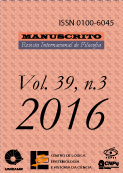Resumen
The subject of this paper is the concept of ‘demonstrative concept’, which has been introduced in philosophy by John McDowell in Mind and World. The analysis presented in the article has a reconstructive and a critical character. Its reconstructive drive may be viewed as required by the concise mode the philosopher adopted to present his theoretical innovation and comprehends an effort to make clear: (i) what is the difference between the temporal conditions necessary (a) to give conceptual status to the color shade we have before our eyes and (b) to our possession of ordinary concepts; (ii) the sui generis character of the universality proper to demonstrative concepts and the uniformity of their relations to what they are concepts of; (iii) the equivalence of their semantical regime to that which is proper to concepts of measurement standards; (iv) the very singular function performed by memory in the constitution and possession of demonstrative concepts. Now, the critical character of the paper firstly lies in the remark that there is a kind of inconsequence in the way McDowell conceives the employment of those concepts, namely in his refusal to admit that even though it is natural to say ‘I see the shade in my mind’s eye’, it would be a mistake to think that when we recognize a color shade as being the same as the one we have seen before there is an inner comparison of it with the retained sample. The second of the paper critical points is the warning that, considering the complex constitution process of demonstrative concepts and its exacting semantic, it seems impossible to take them as coextensive to our human experience of colors.Citas
ALMOG, J., PERRY, J., WETTSTEIN, (eds.) Themes from Kaplan. NewYork – Oxford: Oxford Universty Press, 1989.
AYERS, M., Sense Experience, Concepts and Content – Objections to Davidson and McDowell, in Shumacher (ed.), 2004.
BREWER, B. Perception and Reason. Oxford: Oxford University Press, 2003.
BRUNER, J., In Search of Pedagogy – Volume I: The Selected Works of Jerome Bruner 1957-1978. New York: Routledge, 2006.
CHUARD, PH., “Demonstrative Concepts without Re-identification”. Philosophical Studies, vol. 130, (2006): 153-201.
CODATO, L., “Lições de Giannotti sobre lógica e ontologia” – Entrevista, in Cadernos de Filosofia Alemã – Crítica e Modernidade, 17, (2011): 113-128.
DAVIDSON, D. AND HARMAN, G. (eds.) Semantics of natural Language, Dordrecht, Holland-Boston: D. Reidel Publishing Company, 1972.
DELEUZE, G., Différence et repetition. Paris: P.U.F., 1968.
DERRIDA, J., Gramatologia, trad. De Miriam Schnaiderman e Renato Janine Ribeiro, São Paulo: Perspectiva – EDUSP, 1973.
DOGNIN P.-D, Les «sentiers escaprés de Karl Marx – Le chapitre I du «Capital» traduit et commenté dans trois rédactions successives. Paris: Les Édition Du Cerf, 1977.
EUCLIDES, Os treze livros dos Elementos. Great Books of the Western World, II, New York: Encyclopedia Britannica, Inc., 1952.
EVANS, G. Varieties of Reference. Oxford: Oxford University Press, 1992
FARIA, P., “A preservação da verdade”, O Que nos Faz Pensar (PUCRJ), v. 20, p. 101-126, 2006.
FARIA, P., Correspondência pessoal. 2007.
FORD, A., HORNSBY, J. AND STOUTLAND, FR. Essays on Anscombe’s Intention. Cambridge, Mass.: Harvard University Press, 2011.
FARIA, P., Action and Generality. (in Ford e alii, 2011).
GIANNOTTI, J. A., Os imperativos da ilusão, em Trabalho e Reflexão, São Paulo: Brasiliense, 1983.
GOODMAN, N., The Structure of Appearance. Dordrecht, HoillandBoston:D. Reidel Publishing Company, 1977.
GRANGER G.-G., Filosofia do Estilo, São Paulo: Editora Perspectiva, 1968. Husserl, Texto nº 7 in Husserl ([1909],2005).
EDMUND HUSSERL, Phantasy, Image Consciousness, and Memory (1898-1925), Dordrecht: Springer, 2005. (Esse volume contém a tradução para o inglês, de John B. Brough, do volume XXIII da Husserliana.
KANT, I. Lectures on Logic, New York: Cambridge University Press, 1992.
KANT, I. Lectures on Metaphysics. New York: Cambridge University Press, 1997.
KANT, I. Metaphysik Mrongovius, (in Kant, 1997).
KANT, I. The Vienna Logic (in Kant, 1992).
KAPLAN, D. Demonstratives. in Almog, Perry e Wettstein, 1989.
KELLY, S. D., “Demonstrative Concepts and Experience”. The Philosophical Review, Vol. 110, No. 3 (Jul., 2001).
KRIPKE, S. Naming and Necessity (in Davidson, D. and Harman, G. (eds.), 1972.
LEPORE, E. E LUDWIG, K. “The Semantics and Pragmatics of Complexes Demonstratives”. Mind, vol. 109, (abril de 2000), pp. 199-233.
MARGOLIS, E. E LAWRENCE, S. (eds.) Concepts – Core Readings, Cambridge, Mass.:The MIT Press, 2000.
MCDOWELL, J. Mind and World, Cambridge Mass.: Harvard University Press, 1996. Tradução brasileira de João V. G. Cuter, intitulada Mente e Mundo, São Paulo: Ideias & Letras, 2005.
PLATÃO, Menon, 97c-98a. Tradução de Jorge Paleikat, Porto Alegre: Editora Globo, 1962.
PANACCIO, CL. Les mots, les concepts et les choses. Montréal e Paris: Belarmin e Vrin, 1991.
PEACOCKE, C., Précis of A Study of Concepts, (in Margolis, E. e Lawrence, S. eds. 2000).
PERINI, E.. Correspondência pessoal, 2008.
PERRY, JOHN, The Peoblem of the Essential Indexical and Other Essays, Stanford, California. CSLI Publications, 2000.
QUINE W. VAN O., Word and Object. Cambridge, Mass.:The MIT Press, 1999 (1960).
SCHUMACHER, R., (ed.) Perception and Reality from Descartes to the Present. Paderborn: Mentis, 2004.
WITTGENSTEIN, Philosophical Investigations. 3th Edition, translated by G. E. Anscombe, New York: Macmillan Publishing Co., Inc, 1958.
PYLYSHYN, Z. Seeing and Visualizing – It’s Not What You Think, Cambridge, Mass.: The MIT Press, 2006.

